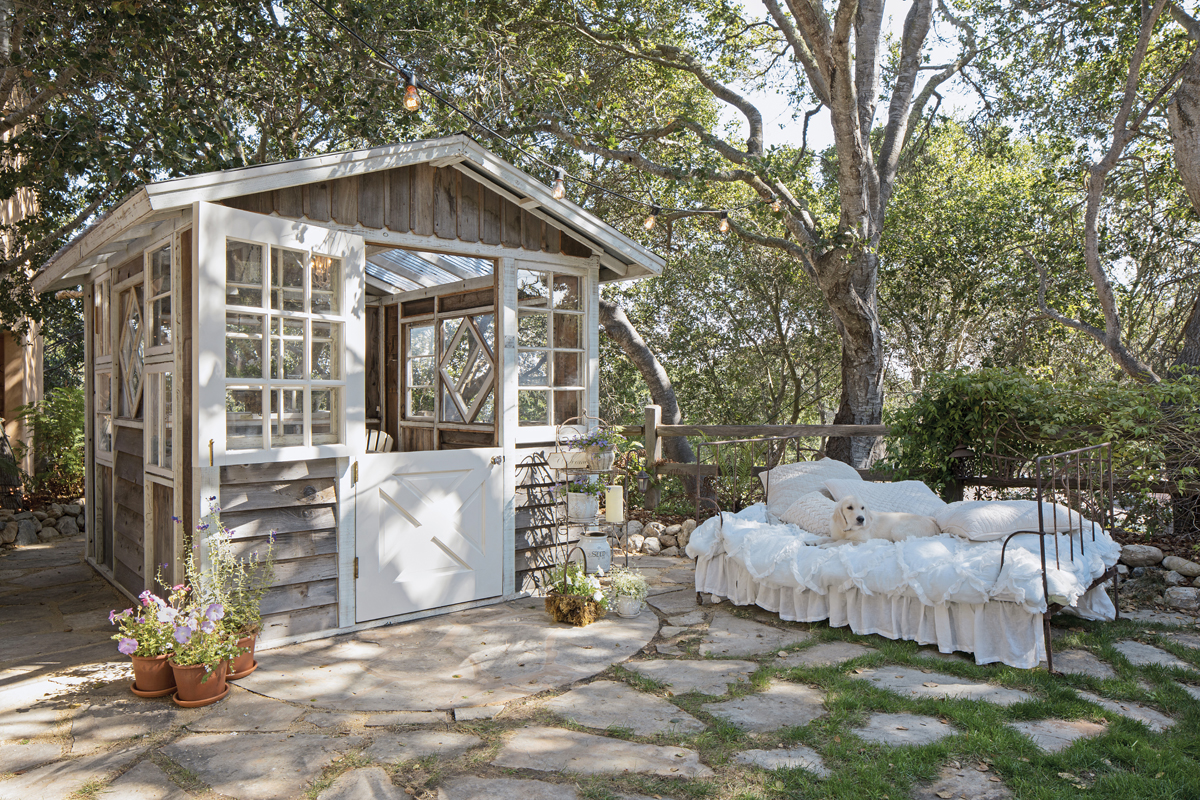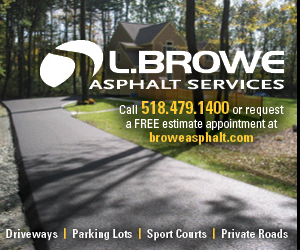It’s a fun phrase, and to be honest I see it ridiculed here and there,” said Erika Kotite, author of She Sheds Style, the 2018 follow-up to her 2017 book She Sheds: A Room of Your Own. “But it is actually just an easy way of labeling something that is really bigger than its name implies.”
Kotite—who also runs SheShedLiving.com as a gathering space for like-minded women, and sells a line of paints called She Shades—discovered she sheds herself only a few years ago when book publishers, The Quarto Group, asked her to research the subject. She had been a magazine editor for a number of years, with a strong interest in Victorian homes and interior design. Since outbuildings were a common feature of Victorian homes, she seemed a logical choice.
What she learned was that while she sheds are attractive additions to backyard landscaping, and can add to property values, they are really about a woman’s need for a private place to call her own.
“No matter how big your house is, it just feels like it’s not quite big enough, right?” she said. “So many women are space challenged, and that really can be detrimental to your mental health. So, my guiding light was all about helping women find their own space. And being that it is about a woman’s space and something that will bring her joy, that space needs to be as pretty as possible.”
Kotite’s first book served as an introduction to the whole concept of she sheds. The new She Sheds Style provides guidance for those who want to build one.
 Why build a she shed?
Why build a she shed?
While it may seem that the she shed movement began as a reaction to the “man cave,” they actually have their roots in the old potting shed.
“They are a direct relation to sheds that were used very practically to store plants and tools, but they were big enough for women to stand in while they potted,” Kotite said. “Then they morphed into something where there was a nice comfortable chair, so she could maybe have a cup of tea. So, that was an important influence on this emerging movement.”
Although there are no statistics on exactly how many she sheds are out there, popular culture holds evidence of their growing popularity. Kotite pointed to the “game-changing” State Farm commercial in which a woman whose shed has been struck by lighting remarks that the insurance money will buy her a “chichier she shed.”
There are a number of uses for the she shed, including a home office, an art studio, a yoga studio, a quiet spot to read or write and a cozy place to entertain friends. Kotite herself has a simple 6’ x 6’ shed with a comfy chair, a lamp and all of her favorite books.
But no matter the use, a she shed can be the ideal solution for the woman in search of space. Kotite notes in She Sheds Style that “no other building marries scale, convenience, usefulness, affordability, and charm in quite the same way.”
In an interview, she added that “If you’re a woman with creative aspirations or a woman with a family and you are trying to work from home but still keep that professional distance, there is nothing like a detached four-wall structure. I don’t care how private your extra room is; it’s different when you walk out the door of your house, and you walk into another structure.”
She noted that, for many people, it is a need that starts young.
“It is not an accident that children seek out playhouses and tree forts and clubhouses and all those places they could call their own, where they had control over their own lives and where they had quiet, and it had meaning for them.”
In addition to the psychological benefits of a she shed, there are practical advantages. Sheds offer enhanced property value, extra room for living and working, and an attractive element that adds to your backyard landscape. Kotite said real estate agents are showing interest in the movement, highlighting sheds in property descriptions and pointing out when yards are large enough to accommodate one.
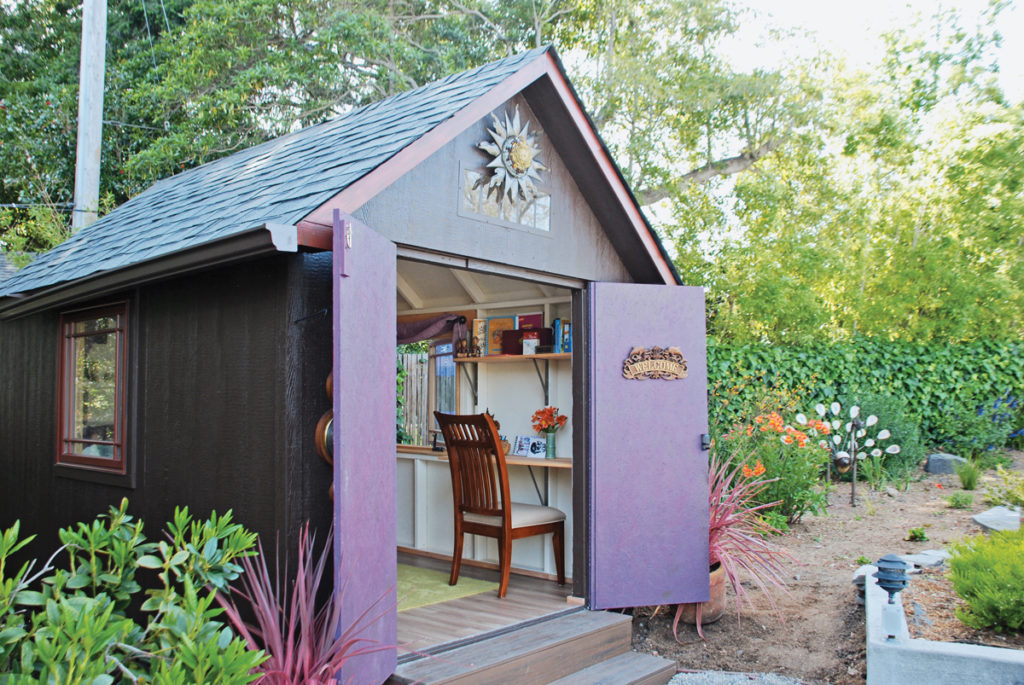 Important considerations
Important considerations
When deciding whether or not to build a she shed, the first question to ask yourself is “What will I use it for—and will I actually use it?”
“That is a hard question to answer honestly,” Kotite said. “But it is important, especially for women who don’t spend a lot of time in their yards. I feel like you need to have a really specific reason that you are going to use it for. Otherwise, it is just going to sit there.”
The next question is, is it within your budget? The average custom-built she shed costs between $15,000 and $20,000. While this is about half of what it would cost to add a room to your house, it is still a big investment.
Kotite said there are some tricks to keep costs in check. As the two biggest costs factors are materials and labor, the first suggestion is to take some time to collect your materials. Look on Craigslist or scavenge around for odds and ends like vintage bricks, old barn wood, and cast-off windows.
“They can make for a really cool looking shed and a lot of times they are cheap, especially in [upstate New York] where there are a lot of historic properties, and some of them are falling down, and a lot of those elements are thrown away,” she said.
Once you have a cache of materials, ask yourself if you or anyone you know has building skills. If so, get as much free labor as you can and host a party similar to an old barn-raising.
“If you are really lucky, you can build a nice shed for $2[000] or $3,000,” she said.
Another option is to use a kit shed, purchased from a home improvement store. Those average $5,000 to $7,000 for a 10 X 12-foot structure. But Kotite discovered the hard way that the kits do not include any roofing materials, which will add to your expense. Furthermore, they do not have the charm and individuality of a custom-built shed. Kotite recommends improving the look of a kit shed by swapping the standard door for a “cool French door” and giving yourself big windows.
The next considerations are whether your property will accommodate a she shed and if there are any community codes or Homeowners’ Association rules to get in the way. If your answers are “yes” and “no,” respectively, it is time to select a site.
Kotite said that in an ideal world, the she shed is built on a small rise of land, far enough from the main house for privacy, surrounded by mature trees and gardens. In the real world, look for a spot where the ground is level and drainage is not a problem. Think about the distance from the main house and choose a location that close enough for convenience but far enough for privacy.
Try to think like a landscape artist. Kotite advises that the best shed placement considers the entire back yard, including light, setback from property lines, and the ability to open and shut the door. A shed can also create a barrier between your yard and a neighbor by filling in a gap in a fence or line of trees.
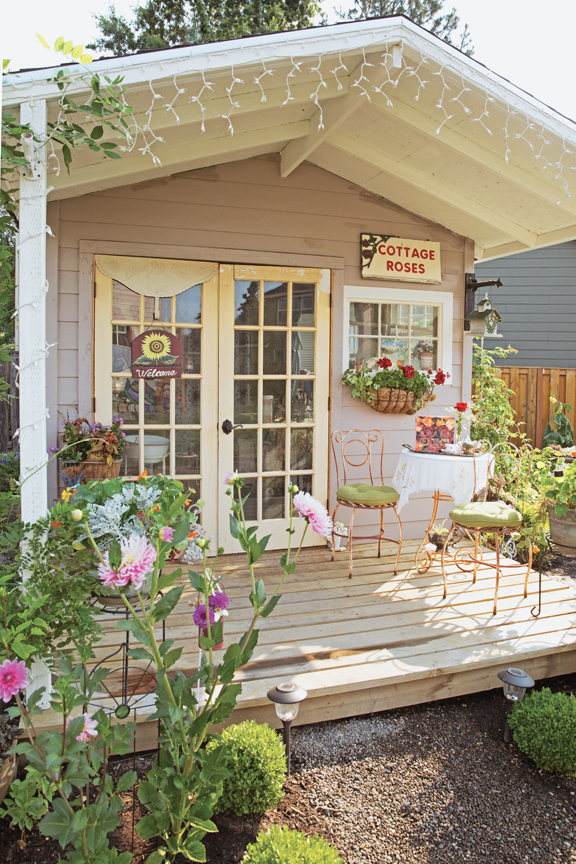
Designing your she shed
Once you have gone through all your due diligence and asked yourself all of the important questions, you are ready to design your she shed. The four walls—custom-built or kit—are just the beginning. The whole shed, interior, and exterior should be planned out before you actually start building.
There are a number of choices to be made. In the Northeast, one of the first things to consider is the weather.
“The cutest she sheds are the ones that aren’t entirely finished,” Kotite said. “They show their structure. They are not all drywalled and insulated. So, you have to think about ‘do I want it as a seasonal structure, or do I want to finish it and seal it so I can be comfortable in all kinds of weather?’”
Whatever you decide, the exterior walls are a vital part of the shed’s architectural appeal as well as its durability. The materials you choose and how you use them will define your shed’s style. In She Sheds Style, Kotite notes that metal, concrete, stone, wood and even synthetic components each offer properties of strength, protection and design appeal. Wood, for example, brings stability, strength, and style. Metal is a good option for roofing because it protects against rain.
The entrance to a she shed should be warm and inviting and match its overall style and purpose. Doors should be sturdy and easy to open, but also attractive. Consider double French doors or Dutch doors for a romantic look, or doors crafted from old barn wood for a more rustic appeal. You might even find a unique vintage door at a second-hand shop. A plain door can be spruced up with a crystal doorknob or brass hinges.
The area around the door should be as carefully designed as the structure itself. Possibilities include fencing, shrubbery, and a garden.
It is now time to move to the inside. According to She Sheds Style, the best place to start your interior designing is with a scaled space plan. Make a simple drawing, with one square inch representing one square foot of space. Place your larger furniture pieces—tables, chairs, desks, etc.—first and build other elements around them.
Think about how you will be using the shed. A gardening shed needs spots for plants, tools and so on. An artist studio needs an open floor plan and lots of natural light. A reading spot needs a comfy chair, a lamp and maybe a footrest.
Plan what will go against your walls—bookcases, storage cabinets, what have you—before you plan your windows. Consider built-ins, such as shelving and cubbies, to save space. If you have a lot of items to store, you may even think about a “built out,” such as a small closet behind the shed.
Another decision involves what kind of flooring you will have. Considerations include overall style, use, endurance, difficulty to install and budget. A wood floor may be attractive but could allow moisture to seep in. Kotite recommends raising the floor on wood supports. If your shed is on a dry, level area, consider a concrete foundation. You can leave it alone or cover it with vinyl, tile or carpeting.
“The cool thing about a shed is that it is so small that if you select carpeting or other flooring that is kind of on the pricy side per square foot, you only need a small amount,” Kotite said.
You will also want to think about your ceiling. Remember, if you are using your shed as a place to unwind you may be looking up a lot. The structural elements of a ceiling can become part of your decorative scheme. For example, trusses and crossbeams are perfect for displaying textiles, hanging plants or stringing lights.
Lights (as well as space heaters, laptops, and many other necessities) require electricity. This is not a topic Kotite addresses in her book, but she said in an interview that most women use an “RV plug” rather than hard wiring.
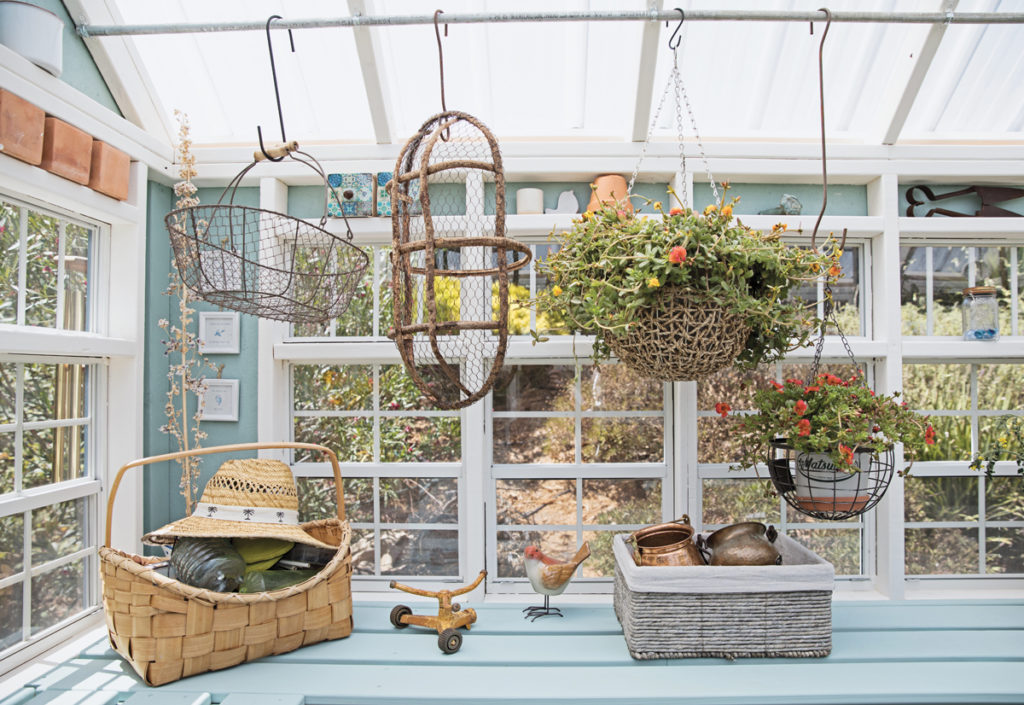 Decorative touches
Decorative touches
The colors, furnishings and other details of your shed give you the most opportunity to infuse it with personality. Kotite advises taking your time with this stage.
“This will be an enjoyable part of shed building,” Kotite wrote. “Give yourself time to know the physical layout of the shed and the way the light hits. Getting to know the nooks and crannies will help your vision fall into place.”
When it comes to choosing your color scheme, start by thinking about what you don’t want. Once those shades have been eliminated, purchase sample sizes of any colors you are still considering. An eight-ounce can cost less than $5 and will allow you to see what the color looks like in your shed’s lighting. Invite your friends over for a painting party to get their opinion.
To pick an exterior color, first, decide if you want your shed to blend into its surroundings or stand out. As for internal colors, remember that lighter colors reflect light, reduce shadow and give the shed a more spacious feel. You may also want to think about the therapeutic value some colors have. Blue, for example, is said to have a relaxing effect.
No matter what colors you choose, Kotite offers these words of advice: “If you are going to paint your shed, use a spray gun.”
Décor may include a pretty accent rug, art objects, mirrors, signs, flowers, wall hangings, whatever speaks to you. Furnishings will be determined in large part by the purpose of your shed but can still have some personality.
“Don’t feel bad about investing in one special piece—an area rug, a chandelier–something that is your splurge,” Kotite said. “But for the rest of it, try to use your cast-off furniture, all the things that are wasting away somewhere that you could give new life in that shed. That is one of the joys of having a shed—space to put things that don’t have a home in your home.”
While building, designing and decorating a she shed should be an enjoyable experience, Kotite offers these final words of advice: “Get serious about it and treat it as a serious project. You want to build it to last. You want it to be sturdy. You want a solid foundation. You want the best materials you can afford. This is not a playhouse. It is fun, and you should enjoy the journey of creating it but you’re a grown woman, and you need to treat this seriously.”

